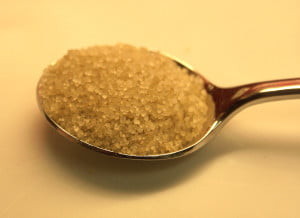 Sugar might not be so bad, if it wasn’t in almost everything!
Sugar might not be so bad, if it wasn’t in almost everything!
And it’s not just in cookies and cakes, chocolate and ice-cream, it’s in all of your sauces and dressings, breads and even sometimes in mixed herbs. Avoiding sugar, is a conscious choice of checking labels and asking questions when purchasing. It is a difficult journey and even the most diligent cavemen can oversee sugar content.
Bacon for example, almost always includes sugar. It can be said, that this use of sugar acts as a Probiotic, thus acceptable. There is much to debate on this topic.
Basically, everything in moderation right? This is the phrase I get a lot from my Non-Paleo friends and family. Unfortunately, sugar is not a moderately used substance in today’s food industry.
Sugar is an extremely broad term. There are monosaccharides ( glucose or fructose), dissacharide (table sugar) and polysaccharides, which translates to ‘many sugars’ and are found in flour, corn, rice, potatoes etc.(Complex carbohydrates. Just remember where these guys are placed on the food pyramid – the big part on the bottom….)
I first want to share one of the most surprising facts I have learnt on my Paleo Path – which is that the body doesn’t need for you to ingest much sugar at all, as it is quite capable of converting the protein and fat you eat into glucose. Yes, your body can make it’s own sugar!
The Paleolithic diet comes from the idea that before the agricultural revolution ten thousand years ago, man was healthier and ate way less sugar. (Bodies dug up from this period show, cavity free teeth and strong athletic skeletal structure.) They were not over eating sugars. They couldn’t duck down the shop buy some french bread and a snickers when need be. Their bodies made their own sugar when it wasn’t available in their diet.
Firstly;
Too much sugar messes with the hormone, Insulin. Insulin is the mail room dispatch guy with a cap on. He distributes all the nutrients you eat into all of the different body cells. It’s tough, he needs to concentrate and do his job right. If you overload him with too many sugars, he messes up. You can get hypo, dizzy and lethargic all in one day, if you interrupt his busy job. (I think the insulin/pancreas/diabetes story is old, so I am going to leave it for now and anyway I think it really belongs in the no-grain section)
Where does sugar go after I eat it?
Sugar is stored as Glycogen in either your muscles (if you have any..:)) or in the Liver.
The Liver has a Glycogen limit. When it gets full, all of the access sugars go to your ass, hips etc. and it transforms into something called Palmitic Acid.
Palmitic Acid causes chaos with your metabolism and the hormone, Leptin.
Leptin is the hormone that controls your appetite. So if your Leptin is wonky, you start to overeat, eat more than you need, and start to crave sugar. Basically any disturbance to Leptin, makes you look old and fat.(its is also an important hormone in the anti-ageing process)
One more thing – most fruit is high in sugar, called fructose.
So many people eat heaps of fruit, and wonder why they aren’t losing weight, or they might feed their children lots of fruit and think it is healthy.
But really depending on your intake of carbs, like bread and pasta, or store bought condiments, a high fructose diet, may not be really healthy or aid in weight loss.Just saying.
Eating fruit with a low sugar content is helpful.This link might help. http://thepaleodiet.com/fruits-and-sugars/
I really love food documentaries, so I am going to leave you with this really cool Aussie guy, who isn’t Paleo but has a great story to tell. We watched this one with our kids, they liked it – it has a lot of cartoons.